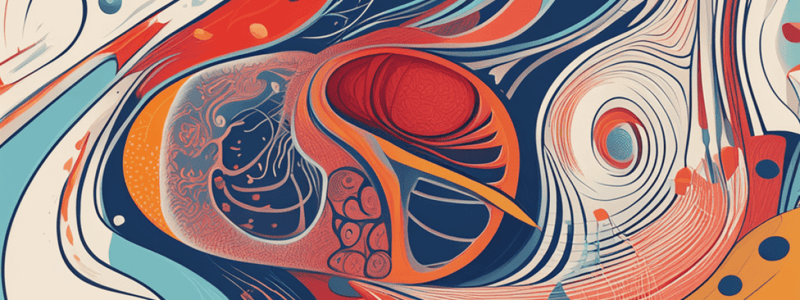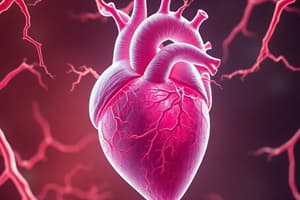Podcast
Questions and Answers
During vasculogenesis, where do the blood vessels develop from?
During vasculogenesis, where do the blood vessels develop from?
- Endoderm
- Mesoderm (correct)
- Ectoderm
- Exoderm
What is the main difference between vasculogenesis and angiogenesis?
What is the main difference between vasculogenesis and angiogenesis?
- Vasculogenesis involves the formation of brand new blood vessels, while angiogenesis involves the sprouting of blood vessels (correct)
- Vasculogenesis develops from ectoderm, while angiogenesis develops from mesoderm.
- Vasculogenesis involves the sprouting of blood vessels, while angiogenesis forms brand new blood vessels.
- Vasculogenesis occurs in the 2nd week, while angiogenesis occurs in the 3rd week.
What does angiogenesis primarily involve?
What does angiogenesis primarily involve?
- Sprouting of blood vessels (correct)
- Formation of brand new blood vessels
- Development of red blood cells
- Development of angioblasts
Where do the paired endocardial heart tubes form during vasculogenesis within the embryo?
Where do the paired endocardial heart tubes form during vasculogenesis within the embryo?
What day does the embryonic heart begin beating?
What day does the embryonic heart begin beating?
Which type of chorionic villi is characterized by the presence of blood vessels (capillaries) within the mesenchymal core?
Which type of chorionic villi is characterized by the presence of blood vessels (capillaries) within the mesenchymal core?
Why is a circulation that exchanges between maternal and fetal tissues necessary in the context of embryonic growth?
Why is a circulation that exchanges between maternal and fetal tissues necessary in the context of embryonic growth?
What is the primary function of the cytotrophoblastic shell in chorionic villi?
What is the primary function of the cytotrophoblastic shell in chorionic villi?
When does the presence of blood vessels and red blood cells in the fetus coincide with the beginning of gas, nutrient, and waste exchange between mother and embryo?
When does the presence of blood vessels and red blood cells in the fetus coincide with the beginning of gas, nutrient, and waste exchange between mother and embryo?
Where do the red blood cells develop first in the early embryo?
Where do the red blood cells develop first in the early embryo?
Which vessel returns blood from tertiary villi back to the embryonic heart?
Which vessel returns blood from tertiary villi back to the embryonic heart?
What happens by the 4th week regarding the paired heart tubes?
What happens by the 4th week regarding the paired heart tubes?
Which structure brings the atria superior as it bends in a counter-clockwise direction?
Which structure brings the atria superior as it bends in a counter-clockwise direction?
From which vessel does blood flow through the umbilical vesicle in the early 4th week of embryonic development?
From which vessel does blood flow through the umbilical vesicle in the early 4th week of embryonic development?
What is the role of syncytiotrophoblast in the maternal-fetal circulation?
What is the role of syncytiotrophoblast in the maternal-fetal circulation?
Why does the syncytiotrophoblast prevent the endometrium from being lost during menstruation?
Why does the syncytiotrophoblast prevent the endometrium from being lost during menstruation?
What effect does hCG have on the ovary?
What effect does hCG have on the ovary?
Which cellular component forms primary chorionic villi projecting into the lacuna?
Which cellular component forms primary chorionic villi projecting into the lacuna?
How does the trophoblast contribute to the nourishment of the embryo?
How does the trophoblast contribute to the nourishment of the embryo?
Flashcards are hidden until you start studying
Study Notes
- Development of embryonic vessels starts early in the 3rd week, arising from the mesoderm.
- Vasculogenesis involves the formation of new blood vessels from the mesoderm, while angiogenesis involves the sprouting of blood vessels formed through vasculogenesis.
- Angioblasts derived from the mesoderm develop in specialized regions called blood islands, which later develop lumens and become blood vessels through vasculogenesis.
- Within the embryo, vasculogenesis leads to the formation of angioblastic cords in the mesenchyme during gastrulation/neurulation.
- The embryonic heart starts to beat at day 21, coinciding with the presence of blood vessels and red blood cells in the fetus.
- Chorionic villi undergo development stages from primary to tertiary, with tertiary villi allowing for substance exchange between maternal and fetal tissues.
- By the 4th week, the paired heart tubes fuse to form a single ventricle and atrium, with the maternal-fetal circulation depending on fetal cardiovascular structures and endometrial exchange mechanisms.
Studying That Suits You
Use AI to generate personalized quizzes and flashcards to suit your learning preferences.




